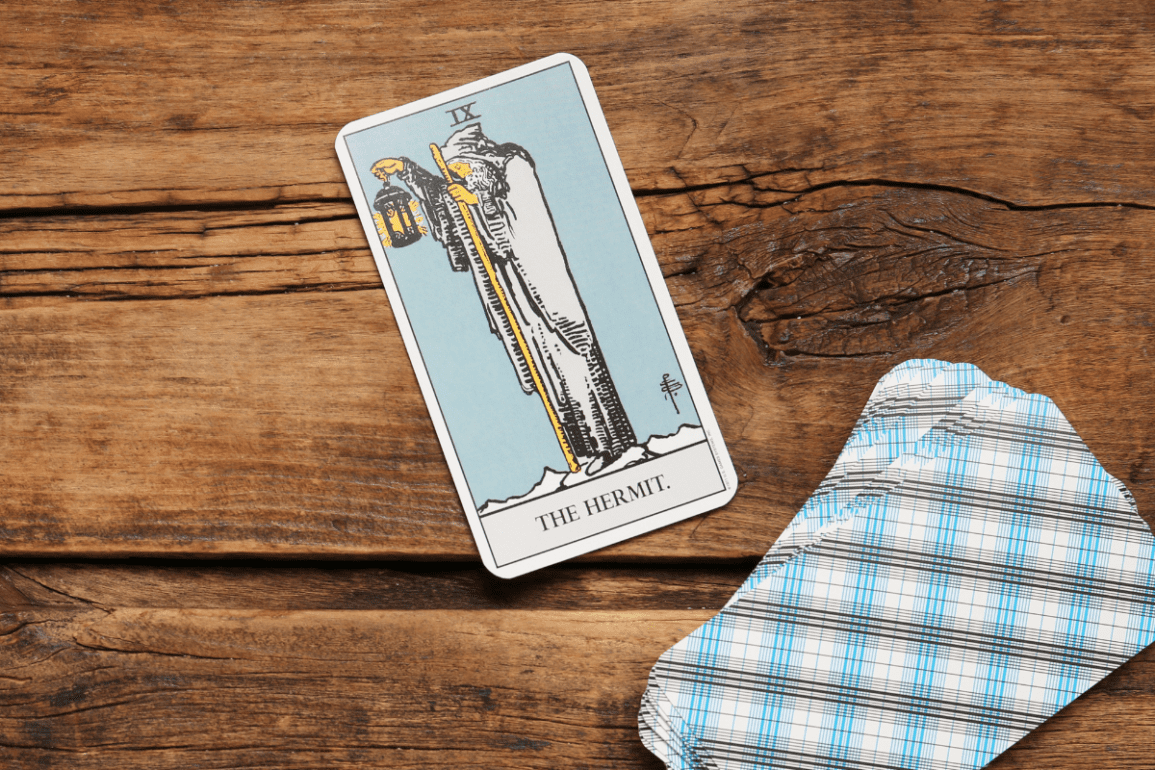The Hermit card in Tarot is a beacon for those on a journey of self-discovery and clarity on feelings.
It stands out in the Major Arcana as a symbol of introspection, solitude, and inner wisdom.
Decoding the Hermit’s meaning can unveil hidden emotions, providing profound insights into our feelings and those of others.
As an evolutionary astrologer and tarotologist, I’ve seen firsthand how the Hermit card can illuminate our deepest truths.
Join me as we explore the Hermit’s insights and uncover the true sentiments hidden within.
And, if you’re curious about the art of decoding the unknown, check out the meaning of all tarot cards in love.
Key Takeaways: What does The Hermit mean in feelings?
- Represents introspection, solitude, and inner wisdom.
- Signals a period of self-reflection and emotional growth.
- Reveals feelings of isolation or the need for personal space.
1. The Hermit’s Inner Light: Self-Discovery and Introspection
The Hermit card represents a profound journey inward.
It’s about turning away from the noise of the external world and seeking answers within.
This card often appears when you need to step back and reflect on your life and emotions.
When the Hermit shows up in a reading, it indicates feelings of introspection and solitude.
You might feel a strong urge to spend time alone, thinking deeply about your life’s direction and purpose.
This introspective period is crucial for personal growth and emotional understanding.
I remember a time when I felt lost, and the Hermit guided me back to myself through quiet reflection.
The Hermit provides honest answers but also reveals negative aspects, encouraging us to confront uncomfortable truths.
Tip: Embrace solitude as a tool for self-discovery, but balance it with moments of social connection to avoid loneliness.
2. The Solitary Path: Embracing Solitude vs. Loneliness
Understanding the Hermit’s solitary path involves differentiating between healthy solitude and loneliness.
When the Hermit appears upright, it symbolizes peace and wisdom found in solitude.
This is a time for introspection, where you seek answers within yourself, fostering personal and spiritual growth.
However, when the Hermit is reversed, it indicates the risks of isolation.
You may feel disconnected from others, leading to a sense of loneliness and emotional detachment.
In relationship readings, this card warns of the dangers of retreating too far into oneself, losing touch with reality and social connections.
Major Arcana cards like the Hermit offer profound answers to life, but must be balanced with external engagement.
During my journey, I found that while solitude helped me find inner peace, too much of it made me feel isolated.
Tip: Balance solitude with social interactions to maintain a healthy emotional state and avoid the pitfalls of loneliness.
3. Introspection in Relationships: What the Hermit Reveals
The Hermit card profoundly affects feelings in both new and long-term relationships.
When upright, it signifies the need for personal space and reflection within the relationship.
You or your partner might need time alone to process emotions and thoughts.
This period can strengthen the relationship by allowing individual growth.
Conversely, the Hermit reversed reveals feelings of disconnection and the challenge of re-engaging with your partner.
There may be a sense of emotional distance, making it hard to communicate and connect.
Understanding these dynamics is crucial for maintaining a healthy relationship.
I’ve seen this play out in my own life, where a little space led to much-needed clarity and reconnection.
Tip: Encourage open communication and respect each other’s need for space to foster a deeper connection and understanding.
You may also like:
14 impressive ways tarot can tell how someone feels about you (plus hidden gems)
The real deal on online tarot reading accuracy (can they truly predict your path?)
4. Unexpected Insights: The Hermit in Love Scenarios
The Hermit card provides surprising insights into love scenarios.
Upright, it represents introspective love, where patience and understanding are key.
You may find yourself or your partner seeking deeper meaning and connection.
This can lead to a stronger, more meaningful relationship.
In the reversed position, the Hermit signifies fear of intimacy and emotional detachment.
There may be a reluctance to open up, creating distance and potential misunderstandings.
However, it also indicates the potential for reconnection with an ex, as both parties reflect on past issues.
Reflecting on my own experiences, the Hermit taught me that sometimes stepping back can bring two people closer together.
Tip: Use this time of introspection to understand your needs and communicate them clearly, paving the way for healthier relationships.
5. Powerful Tarot Pairings: Enhancing the Hermit’s Message
Pairing the Hermit card with other tarot cards can significantly enhance its message. These combinations provide deeper insights and broader perspectives.
For example, the Hermit and the Hierophant together suggest seeking guidance and wisdom in relationships. This combination emphasizes learning from past experiences and mentors to build a healthy relationship.
The Hermit and the Hierophant:
- Seek guidance and wisdom in relationships.
- Learn from past experiences and mentors.
- Build a healthy, stable relationship.
When paired with the King of Pentacles, the Hermit card conveys feelings of stability and security. This duo highlights the importance of a solid foundation and practical support in emotional matters.
The Hermit and King of Pentacles:
- Emphasize stability and security.
- Highlight the need for a solid foundation.
- Provide practical support in emotional matters.
Combining the Hermit with the Moon card involves navigating uncertainty and hidden emotions. This pairing encourages you to confront your subconscious fears and embrace the unknown.
The Hermit and the Moon:
- Navigate uncertainty and hidden emotions.
- Confront subconscious fears.
- Embrace the unknown.
More than once, in a reading with clients, these cards paired and they profoundly clarified their path, showing them areas they needed to explore further. It gave them a clearer understanding of their emotional landscape.
Tip: Explore these pairings in your tarot readings to gain deeper insights into your emotional and relational dynamics.
You may also like: The Emperor and feelings: 8 insider tips to master the art of understanding unspoken sentiments
6. New Perspectives: The Hermit’s Role in Emotional Healing
The Hermit card acts as a guide for emotional healing and self-discovery for your feelings.
Its introspective nature encourages you to delve deep into your psyche and uncover hidden truths.
This journey of introspection can lead to significant personal breakthroughs and emotional clarity.
By reflecting on past experiences and emotions, you can heal old wounds and build stronger relationships.
Use the Hermit’s energy to understand your emotional patterns and release unresolved issues.
This process not only fosters individual growth but also enhances your connections with others.
During a pretty tough period of my life, I turned to the Hermit and it helped me transform pain into wisdom.
Tip: Set aside time for regular self-reflection and meditation to harness the Hermit’s healing power effectively.
7. Embracing the Hermit’s Shadow: Facing Inner Fears
The Hermit card also has a shadow side that involves confronting darker aspects of oneself.
Overcoming the fear of isolation is crucial for embracing your personal truth.
When the Hermit appears reversed, it highlights the dangers of becoming too withdrawn and disconnected.
It’s essential to balance introspection with maintaining external connections.
This balance helps prevent feelings of loneliness and emotional detachment.
Facing these fears and embracing your true self can lead to profound personal transformation.
The Hermit is a spiritual card that, when reversed, can indicate a lack of connection impacting both mental health and emotional stability.
I’ve been there, retreating too far into my thoughts, only to find that reconnecting with others brought me back to life.
Tip: Practice self-compassion and seek support from trusted friends or advisors to navigate the Hermit’s shadow side successfully.
8. The Hermit’s Call to Action: Practical Steps for Inner Work
Incorporating the Hermit’s lessons into daily life to decode feelings and emotions can be transformative.
I remember a time when I felt overwhelmed by life’s demands and disconnected from myself.
That’s when I turned to the Hermit card for guidance.
Here are some practical exercises for introspection and self-reflection:
First, create a space for meditation.
This can be a quiet corner in your home where you feel safe.
Spend a few minutes each day in silence, focusing on your breath.
Second, keep a journal.
Write down your thoughts, feelings, and experiences.
Reflect on them to uncover patterns and insights.
Third, practice mindful walking.
Take a walk in nature and pay attention to each step, the sounds around you, and your breathing.
Using the Hermit’s wisdom helps navigate emotional challenges and enhance relationships by fostering self-awareness and clarity.
Tip: Dedicate just 10 minutes a day to these practices for noticeable improvements in emotional well-being.
Conclusion
The Hermit card is significant in understanding feelings, both your own and others’.
By embracing its light and shadow aspects, you gain profound insights into your emotional world.
This card teaches the importance of introspection and the value of solitude for personal growth.
I hope this exploration of the Hermit’s lessons has been enlightening.
Using the Hermit’s guidance can lead to emotional growth and enhance your relationships.
Remember, self-reflection is key to understanding deeper truths and connecting more authentically with others.
If you found this article helpful, share your experiences or thoughts in the comments.
And if you seek more personalized insights, consider talking to a gifted advisor.




